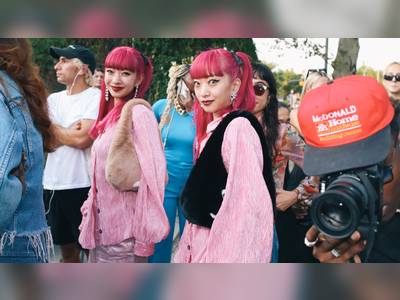With the help of name-brand designers and celebrities, environmentally friendly fashions are getting noticed and are poised for mainstream acceptance. Companies like Nike, American Apparel and Eileen Fisher are offering green items. Clothes made from organic cotton and wool, bamboo, and even soybean and corn-based fibers are showing up on the catwalks and in stores across North America.
Last month, Levi's began selling 100 percent organic cotton jeans. Organic versions of Levi's signature 501 jeans are dyed with natural indigo. The organic Capital E jeans, which retail for $245, have recycled buttons and rivets. Next year, Levi's plans to offer organic cotton jeans in more styles.
The use of organic cotton has increased as producers and consumers become more aware of the environmental costs of conventionally grown cotton. According to the Sustainable Cotton Project, a third of a pound of pesticides is used to produce the cotton for one T-shirt, and 25 percent of all pesticides used in U.S. agriculture are used on cotton.
Patagonia led the way
The outdoor sportswear company Patagonia pioneered the move toward
environmentally conscious clothing. In 1993, Patagonia became the first
major manufacturer to
produce fleece made from recycled plastic soda bottles.
The company switched to organic cotton in 1996.
Patagonia struggled for the first few years after moving to organic
cotton. It had to lower its profit margin and decrease the number of
products it offered to deal with the higher prices and scarcity of
organic cotton, said Coley Glasgow, a spokeswoman for Patagonia. But
the decision ultimately paid off.
"When we made the switch, we were counting on our customers to make the
same choices we had made - to pay more for organics," Glasgow said. "And they did."
With the growing popularity of organic foods and global warming
concerns, the fashion industry started to target environmentally
conscious shoppers.
"Companies get into this because they can see a market in formation,"
said Rebecca Calahan Klein of Organic Exchange. "Consumers under 30 are
extremely environmentally aware; they're a generation that grew up with
recycling."
Fashion innovation typically starts with high-end designers and
retailers because they have the budgets that allow them to take risks.
At New York Fashion Week last year, upscale retailer Barney's teamed up
with the environmental organization Earth Pledge to present
FutureFashion, featuring clothes with ecological benefits. Designers
included Diane von Furstenberg and Oscar de la Renta.
Affordable options
For those with smaller closet budgets, some bargain retailers have
started selling organic cotton active wear. Sam's Club offers organic
jeans for $20 and T-shirts for $10. When the company first introduced
organic cotton products in 2005, they sold out within 10 weeks.
Other low and moderately priced retailers are following suit. According
to the Organic Exchange, the number of large companies with organic
cotton products grew to more than 30 in 2005 from five in 2001.
Mainstream chains like Target and Victoria's Secret are developing
organic lines that are expected to hit the stores in the next two years.
Some environmentalists aren't completely sold on the eco-fashion trend.
"Green consumerism isn't that different from regular consumerism," said
Lynda Grose, who helped design a line of organic cotton clothes for
Esprit in the early 1990s. "Producing and selling more garments is part
of the problem."
Grose, who now teaches sustainable fashion design at the California
College of the Arts in San Francisco, encourages her students to design
clothing that lasts longer.
She adds that the eco-fashion trend will eventually wane, as trends
always do. "And some brands will fall away," Grose said. "But many more
companies are committed for the long haul. The industry has gained
strength and breadth."













